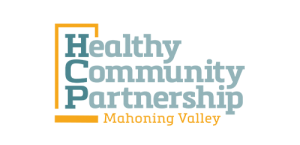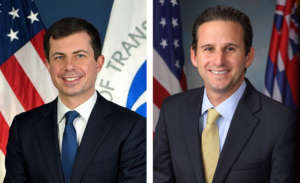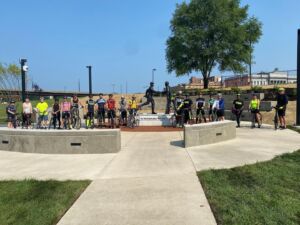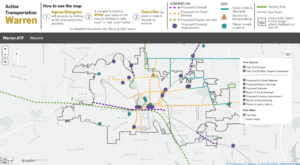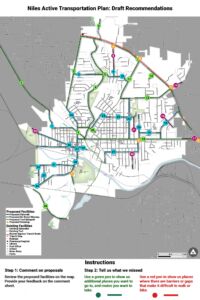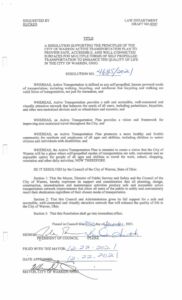Moment of the Month December 2021: Accelerating Active Transportation
Cities of Niles, Warren Adopt Active Transportation Plans & WRTA Expands, Enhances Services
Almost one year ago to the day, when U.S. Department of Transportation Secretary Pete Buttigieg was still a nominee, he was questioned by U.S. Senator Brian Schatz (D-HI), a co-sponsor of the National Complete Streets Act of 2019 and 2021, to share his position, and hopefully support, for a more complete approach to transportation policy:
SCHATZ: Many local transportation departments are Departments of Cars, but transportation is about any way you get around, whether it’s on foot or via rail or bicycle or bus. I think it’s really critical that you lead from the top to clarify that the objective here is to get people where they need to go, not widening the aperture through which the maximum number of cars can get through at the maximum speed.
BUTTIGIEG: It’s very important to recognize the importance of roadways where pedestrians, bicycles, vehicles, any other mode can coexist peacefully. And that Complete Streets vision will continue to enjoy support from me if confirmed.
More about the hearing can be found on the Transportation for America (T4America) Blog.
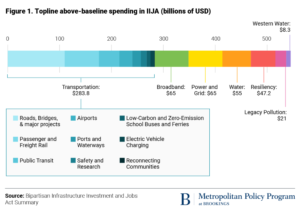
Graphic from Brookings: “America has an infrastructure bill. What happens next?”
Since then, Secretary Buttigieg was confirmed by the U.S. Senate and the Infrastructure Investment and Jobs Act of 2021, a.k.a. the Bipartisan Infrastructure Bill (more affectionately and efficiently referred to as BIB) was passed and signed into law. Though Complete Streets Advocates like Senator Schatz, the League of American Bicyclists, and the Safe Routes Partnership did not see everything on their wishlist survive the “sausage making,” the BIB made it to the finish line with more active transportation priorities intact than before–an historic win by most accounts. A brief overview of major policy wins as summarized by the League of American Bicyclists, the Safe Routes Partnership, and the Biden Administration can be found below.
There are two major milestones in the legislation that signaled victory: there are several policy changes that promote safer walking, biking, rolling, and riding, AND there is funding allocated to making sure these changes result in actual investments that improve the built environment to support active transportation–walking, biking, and public transit.
In addition to increased attention to active transportation priorities in national policy, we’ve also seen shifts and increases in the number of people walking, biking, and rolling for transportation and recreation due to multiple factors connected to the COVID-19 pandemic. In Outside magazine’s article, “The Pandemic Bike Boom is Here to Stay,” Joe Lindsay quotes Blair Clark, president of Canyon Bicycle’s U.S. division, saying that he thinks the trajectory of the “bike boom” will end up look more like a gradual leveling out rather than a sharp drop: “Two big trends we see are people who either returned to the sport or discovered it for the first time and are really falling in love with it, paired with a constantly growing adoption of the bicycle as transportation,” Clark says. Americans,he elaborates, “are finally waking up to the transformative power of bikes for transportation, not just recreation.”
Similarly, there were documented increases in the number and frequency with which people were walking in cities across the world. Specifically in the United States, the Massachusetts Institute of Technology completed a study titled, “Effect of COVID-19 response policies on walking behavior in US cities,” which revealed that yes, in fact, more people were walking over the last two years than in years prior to the pandemic. However, as the pandemic has done for so many previously invisible (to many) inequities, the study exposed an uncomfortable fact:
People in higher-income areas walked more during the pandemic, while people in lower-income areas – including neighborhoods with more BIPOC and those suffering from long-term illnesses like diabetes and obesity – walked less.
Elaborating on this finding, Esteban Moro, a visiting research scientist at MIT, offered a few insights: “We found that high-income people started to walk more even after the lockdowns,” Moro shared with Boston.com in a recent interview. He continued by noting that there’s a “strong correlation” between walking and those with access to pedestrian friendly infrastructure and other facilities. Those living in poorer areas of a city, and those not known to have things like park facilities, well-maintained sidewalks, adequate lighting, and so on tend to walk less.
This is not to suggest that individuals in communities experiencing economic challenges are not walking, but they are walking for different, more “utilitarian” reasons that lead to shorter walks like to and from a transit stop, to work, or to a similar essential destination. These limitations on the motivation to walk or recreate outdoors for individuals in these communities create conditions that make improving health conditions like diabetes, weight status, or other lifelong health challenges more difficult, which make their vulnerability to COVID-19 more pronounced.
But, Moro and his team do offer solutions like co-organizing pop-up walking/physical activity centered events in neighborhoods and improving environmental conditions like lighting to increase safety, especially in the winter months when daylight is at a premium–something we know all too much about in Northeastern Ohio. These improvements will provide benefits to walkers and rollers wherever they are coming from and make sure they can get to wherever they need to go.
This national spotlight on issues related to active transportation demonstrates the urgency and the need to invest resources into building communities and policies that put people first.
The Mahoning Valley is seeing this national trend encourage and inspire local action to accelerate active transportation priorities, plans, and policies. In the waning months of 2021, there were several policy victories that will help the Mahoning Valley shift gears towards becoming a more active, better connected community, and more prosperous community.
Cities of Warren and Niles Adopt the Active Transportation Plans
The most effective route is not always the fastest. This is true for many processes, especially policy making.
In 2020, the Trumbull County Combined Health District assembled an all-star team that participated in the Ohio Department of Transportation Your Move Ohio! Action Institute. Hindsight being what it is, this process kicked off during the worst best, or maybe best worst, time given what has come to pass with regards to the COVID-19 pandemic and its impact on active transportation.
Despite many unforeseen potholes and road blocks, the coalition pushed forward with the process that would result in the Warren City Active Transportation Plan. Starting with creating an interactive map, coalition members and partners encouraged residents, businesses, and other stakeholders to share their aspirations and frustrations with walking, biking, riding, and rolling in Warren. The group also launched a Warren City Active Transportation Facebook Page to continue the conversation and promote active transportation related content.
- Warren City Active Transportation Mapping Tool
- Niles City Active Transportation Mapping Tool
By the end of 2020, the feedback gathered through the map and other surveying tools, the coalition reviewed this information, collected additional data, and developed a plan with implementation recommendations. The next step in the process? Moving from plan to action.
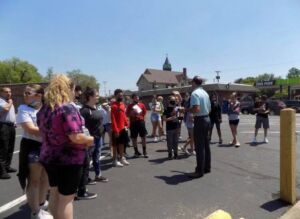
City of Niles Mayor Steve Mientkiewicz and students from Niles Middle School performed a “walk audit” as part of the Niles Active Transportation Planning Process | Photo from Mayor Steve Mientkiewicz
During this time, another Trumbull County city stepped up to begin the process towards becoming a more walkable, bikeable, better connected community: the City of Niles. Led once again by the Trumbull County Combined Health District and an eager representative from city government, Mayor Steve Mientkiewicz, the team got to work to develop another active transportation plan which would, as Mayor Mientkiewicz said so well, “provide updated and safe infrastructure for biking, walking and public transportation. [Mayor Mientkiewicz] said it also focuses on trying to entice and encourage activity among residents.”
Like Warren, Niles had an opportunity for stakeholders to share their visions and suggestions for how to make Niles a better connected, safer, more active city with an interactive map and data collection process. Mayor Mientkiewicz also participated in a walk audit with Niles Middle School students to ensure youth and young adult perspectives were included in the process.
For both plans, a final, critical step requires patience, persistence, and partnership.
The energy and enthusiasm from Mayor Mientkiewicz led Niles City Council to consider and commit to adopt the Niles Active Transportation Plan relatively quickly. By November 2021, Niles City council officially signed off on the Niles Active Transportation Plan. The Mayor and Council commented that, “the goals of the plan are to promote a more healthy and livable community for people of all ages, and to create a place in the city where walking and biking is safe, convenient and enjoyable by all.” This next leg of the journey to implement the recommendations will be just as energizing, exciting, and transformative.
Back to Warren. The Trumbull County Combined Health District and Action Institute coalition members continued to engage with Warren City Councilmembers, sharing the results of the planning process and beginning to forge a path forward for adoption and implementation. The pandemic, again, presented the coalition with delays and detours, but this still did not stop them from pressing forward.
After many months of continued conversation, Warren City Council indicated they were ready to make a move. In preparation for the last council meeting of the year, the Healthy Community Partnership sent a letter to members of the City of Warren Administration and Council applauding their efforts so far and encouraging them to formally adopt the Active Transportation Plan and recommendations. Local news station, WFMJ also previewed the plan and offered commentary on the significance of what adopting the plan could mean for Warren residents’ health and safety.
WFMJ.com News weather sports for Youngstown-Warren Ohio
Just in time for the holidays, Warren City Council presented the community with a final gift before the year wound down and wrapped up: the passage of a resolution formally adopting the Warren City Active Transportation Plan.
Heading into 2022, two communities in Trumbull County have made commitments to challenge themselves to think and act differently than before. The success of these two Active Transportation Plans, and the processes that produced them, hopefully will inspire more communities throughout the Mahoning Valley to take the necessary and rewarding steps towards becoming safer, better connected, and more active places for people to live, work, and play.
WRTA Service Enhancements & Free Fare Extension
Our transportation decisions determine much more than where roads or bridges or tunnels or rail lines will be built. They determine the connections and barriers that people will encounter in their daily lives, and thus how hard or easy it will be for people to get where they need and want to go. — U.S. Congressman Elijah Cummings

“Rides on all WRTA Fixed Route, Late Night, Countywide and ADA All-Access buses are FREE!” | Image from WRTA
As has been noted before, Ohio and the Mahoning Valley too often top the kinds of lists most hope never to find themselves included in let alone be declared “Number 1.” But, there are always exceptions and opportunities to change. One such departure from this listless norm has been brought to the Mahoning Valley courtesy of WRTA.
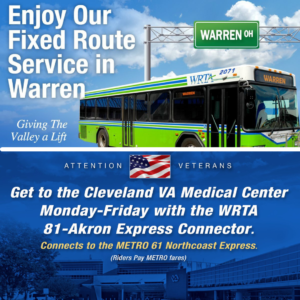
Read more about new fixed route service in Warren and 81 Akron Express at wrtaonline.com | Images from WRTA
As of December 2021, the Western Reserve Transit Authority (WRTA), is the first transit authority in the state of Ohio to implement a system-wide free fare policy. That means rides on all WRTA Fixed Routes, Late Night, Countywide and ADA All-Access buses are completely, 100% FREE. No fares, no fuss.
Free fares, which began as a measure born out of necessity due to the pandemic pummeling public services, are now a few steps closer to staying around for a while—creating a new normal that prioritizes people’s health, safety, and prosperity.
If that wasn’t enough good news to round out the year, WRTA secured another Ohio Department of Transportation Grant that made it possible to reinstate seven new routes in Warren. These seven routes were preceded by another new route, the #81 Akron Express, which transports riders from the Mahoning Valley to Akron METRO Station—this new connection provides opportunities for veterans to travel to the Cleveland VA Medical Center via the Akron METRO 61 Northcoast Express.
As time marches on, it is important to pause long enough to look back and see how far our communities have come before returning to plot out the path forward to the next milestone. Hopefully, the new year will present opportunities to build on the progress and success that has been carefully and tirelessly achieved. The alignment of federal resources and local resourcefulness to invest in policies and projects that promote active transportation have the potential to be truly transformative.
Additional Information re: Federal Active Transportation Policy
The Safe Routes Partnership worked closely with the League of American Bicyclists on two key issues: funding and safety for walking, bicycling, rolling, and Safe Routes to School.
Transportation Alternatives Program (Sec. 11109)
The improvements to the Transportation Alternatives program that unanimously passed the bipartisan Environment and Public Works committee were all included in this bill. Thanks to our Senate champions, Senators Ben Cardin (D-MD) and Roger Wicker (R-MS), we were successful in securing:
- Increased funding that will continue to grow over the life of the bill: Currently TAP is capped at $850 million a year. The Infrastructure Investment and Jobs Act would increase funding by 60% to $1.38 billion in 2022, and would increase each year up to $1.49 billion in 2026. Across all five years, it would mean a $2.5 billion increase for sidewalks, bike lanes, Safe Routes to School programming, and trails.
- Protecting more TAP money: Under current law, states can transfer up to 50 percent of their Transportation Alternatives dollars out of the program. On average, states transfer roughly 20 percent of funding to other uses, which takes funding away from local governments looking to improve safety. The Infrastructure Investment and Jobs Act would only allow transfers if a state has held a competition, provided technical assistance to applicants, and did not have enough quality applicants to use all the funding.
- Help with the Local Match: Small, rural and low-income communities can be deterred from applying for TAP funds they must cover 20 percent of the project’s cost. Under this bill, states would have more flexibility with matching requirements. They could use federal safety funds as the local match for projects that improve safety – including all Safe Routes to School projects. In addition, states would also be able to meet the 20 percent match across all TAP projects, meaning that if a larger community provides a higher local match, the state can then allow a lower match to a high-need community.
- Prioritization of High-Need Communities: The bill requires states to prioritize high-need communities in the application process. States would define what constitutes high-need in their state—such as high-poverty schools or low-income or rural communities.
Safe Routes to School (Sec. 11119)
The Infrastructure Investment and Jobs Act recodifies the Safe Routes to School program into current law and expands it to cover high schools. It also strengthens the language in the federal Surface Transportation Program and the Highway Safety Improvement Program to proactively affirm that those funds can be used for Safe Routes to School projects—rather than just relying on TAP funding.
Highway Safety Improvement Program (Sec. 11111)
Walking and biking make up 12 percent of transportation trips, but pedestrians and bicyclists make up 20 percent of fatalities. Even though this trend has been worsening for several years, states spend just one percent of their safety dollars on improving safety for people walking, rolling and biking (called “vulnerable users” in the Infrastructure Investment and Jobs Act). With the leadership of Senator Carper (D-DE), the Infrastructure Investment and Jobs Act makes a number of changes that would make it safer to walk, bike and roll:
- Create a Safety Plan: Every state would be required to complete a Vulnerable Road User Safety Assessment to study where and when these fatalities and serious injuries are occurring, including a demographic breakdown to ensure equity considerations are incorporated. States must identify projects and strategies to reduce the risk to people bicycling, walking and rolling.
- Ensure Funding Goes to Vulnerable User Safety: States in which vulnerable users represent 15 percent or more of all roadway fatalities would be required to spend 15 percent of their federal Highway Safety Improvement Program dollars on vulnerable user safety. Based on 2016-2018 fatality rates, 28 states would be required to spend more than $200 million on improvements like sidewalks, bike lanes, crosswalks, and more.
- Creating Safe Systems Approaches: The bill overhauls the entire federal safety program to include and consider the safe systems approach, which builds the safety and protection of vulnerable road users into road planning from the start. It also specifically makes Safe Routes to School projects (both infrastructure and programming) eligible for all federal safety funding.
- Improving Knowledge: Finally, the bill requires the Federal Highway Administration to conduct additional research to identify infrastructure and policy interventions that can improve safety for vulnerable road users and encourage more bicycling and walking.
The Infrastructure Investment and Jobs Act creates two new programs relevant to active transportation: the Reconnecting Communities program and Safe Streets and Roads for All.
- Reconnecting Communities Program (Sec. 11509 – $1 billion). President Biden originally called for $20 billion to fund the program, so this falls far short of that, but labeled as a pilot program, this is a starting point for future advocacy to undo the harmful legacy of the construction of highways in Black communities and other communities of color.
- Safe Streets and Roads for All (Sec. 24112 – $5 billion) This program creates a grant program administered by the USDOT to fund planning and implementation of “comprehensive safety action plans” – Vision Zero and Toward Zero Deaths plans, in practice. Cities and other sub-state jurisdictions, MPOs, and tribal governments are eligible to apply for these funds. 40% of funds would be required to spend on developing these plans, and the remainder can be used for implementing them. There is a lot of good in this program, however, it also permits enforcement of traffic laws as a permissible use of these funds with no safeguards to protect against the harmful implications of traffic enforcement.
- Complete Streets (Sec. 11206) Requires that states and MPOs adopt plans to consider the needs of multimodal road users of all ages, abilities, and travel modes.
Source: Safe Routes Partnership Blog, “Congress Passes Infrastructure Bill Making a Historic Investment in Safe Routes to School, Walking, and Bicycling”
White House Fact Sheet re: Bipartisan Infrastructure Bill
Repair and rebuild our roads and bridges with a focus on climate change mitigation, resilience, equity, and safety for all users. In the United States, 1 in 5 miles of highways and major roads, and 45,000 bridges, are in poor condition. The legislation will reauthorize surface transportation programs for five years and invest $110 billion in additional funding to repair our roads and bridges and support major, transformational projects. The Bipartisan Infrastructure Deal makes the single largest investment in repairing and reconstructing our nation’s bridges since the construction of the interstate highway system. It will rebuild the most economically significant bridges in the country as well as thousands of smaller bridges. The legislation also includes the first ever Safe Streets and Roads for All program to support projects to reduce traffic fatalities, which claimed more than 20,000 lives in the first half of 2021.
Improve transportation options for millions of Americans and reduce greenhouse emissions through the largest investment in public transit in U.S. history. America’s public transit infrastructure is inadequate – with a multibillion-dollar repair backlog, representing more than 24,000 buses, 5,000 rail cars, 200 stations, and thousands of miles of track, signals, and power systems in need of replacement. Communities of color are twice as likely to take public transportation and many of these communities lack sufficient public transit options. The transportation sector in the United States is now the largest single source of greenhouse gas emissions. The legislation includes $39 billion of new investment to modernize transit, in addition to continuing the existing transit programs for five years as part of surface transportation reauthorization. In total, the new investments and reauthorization in the Bipartisan Infrastructure Deal provide $89.9 billion in guaranteed funding for public transit over the next five years — the largest Federal investment in public transit in history. The legislation will expand public transit options across every state in the country, replace thousands of deficient transit vehicles, including buses, with clean, zero emission vehicles, and improve accessibility for the elderly and people with disabilities.
Make the largest investment in passenger rail since the creation of Amtrak. U.S. passenger rail lags behind the rest of the world in reliability, speed, and coverage. China already has 22,000 miles of high-speed rail, and is planning to double that by 2035. The legislation positions rail to play a central role in our transportation and economic future, investing $66 billion in additional rail funding to eliminate the Amtrak maintenance backlog, modernize the Northeast Corridor, and bring world-class rail service to areas outside the northeast and mid-Atlantic. This is the largest investment in passenger rail since Amtrak’s creation, 50 years ago and will create safe, efficient, and climate-friendly alternatives for moving people and freight.
Source: White House Fact Sheet: The Bipartisan Infrastructure Deal
